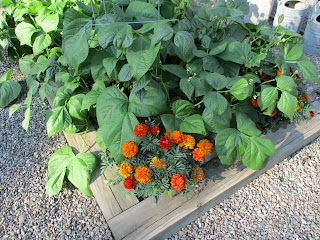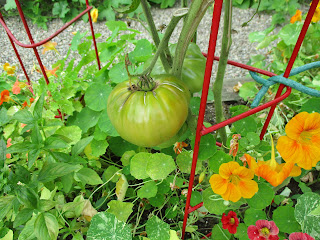Over the years I've learned a few simple gardening methods which make gardening so much more enjoyable. They fall under "risk avoidance". There are problems you can avoid with good planning and never have to deal with them at all. When I see people searching for a solution for a problem I just want to tell them how they could have avoided it completely. Some things cannot be fixed. But an ounce of prevention is worth a pound of cure.
The answers that the Gardening Public usually throw at the poor people is "Try Epsom Salts" or "Water more". Well, I don't know what your gardening problem is, but unless it is a magnesium deficiency in your soil, Epsom Salts will probably not cure it. Just sayin'. Buying a good old fashioned real live paper gardening book wouldn't hurt.
Problem: Bitter Cucumbers
Solution: Choose varieties that are
gynoecious (produces only female flowers) and/or parthenocarpic (produces fruit without fertilization). My favorite variety is
Bristol. Apparently, bitter cucumbers come from male pollinated fruit. And it seems to be made worse by inconsistent watering. I buy my seeds from Johnny's Seeds and they always label their varieties well. Also, when in doubt - water. Sometimes it can be difficult to decide whether you should water or not. If you aren't sure - at least water the cucumbers. And the bush beans. More on that later.
Problem: Powdery Mildew on Squash
Pre-Emptive Solution: Choose varieties with high resistance. This usually means planting F1 hybrids, not heirlooms or fancy foreign varieties, but at what price sanity? My favorite variety many years running is
Dunja. You can also plant backups a week or two later and keep them in an isolated area. Summer Squash and Cucumbers have a fairly short season. Better to have two or even three short seasons in a row than to try to keep worn out vines going past their prime.
Problem: Squash Vine Borer and Cucumber Beetles
Pre-Emptive Solution: Plant later in the season. A co-worker told me that his father taught him to never plant a cucumber plant before the first week of June. That way when the Cucumber Beetles hatch in the spring, there are no yellow flowers to attract them. This apparently works for Squash Vine Borer too. I only see the SVB moths in May. I don't seed zucchini until June. By then the moths seem to have moved on. And besides - good things come to those who wait
Problem: Bell Peppers not Ripening
Pre-Emptive Solution: Plant them in large containers. Do yours take forever to ripen? They do in my zone 5b. If the plants are still going strong when frost is imminent, move the containers to the patio and/or cover them when frost threatens. You can extend your season several weeks.
Problem: Stubby Carrots
Pre-Emptive Solution: Is your soil too hard and not tilled deeply enough to give you long, flawless carrots? Containers and loose potting mix is the answer. People who grow perfect carrots for fair exhibits actually
use PVC tubes and sand. THAT will give you a long straight carrot!
Problem: Curly Green Beans
Pre-Emptive Solution: Bush beans can be tricky. For one thing, they aren't always bushy. Know this in advance.
Some harbor secret ambitions to be pole beans. And being broad leaved, they are susceptible to wilting in the afternoon heat. These things combined mean that your bush beans may soon be sprawling all over the ground under their own weight and the abuse of the sun. And all of this up and down business means that they will continually stub the bean ends into the ground. The result is curly beans. And I like straight beautiful beans. And even worse, the tips touching the ground can lead to rot. And then it's ruined. The way around this is to always plant your bush beans (or at least your new varieties until you know how they'll act) on pea trellis just in case they want to climb. And keep them well watered. Problem solved.
Problem: Cabbage Moths
Pre-Emptive Solution: Cover your crop. Whether it is broccoli, cauliflower, cabbage, brussels sprouts or kale, your crop will be prettier and much more successful if you keep those little white butterflies out of it. This means either covering it with a floating row cover or some kind of wire mesh. Or both. The wire above is just large enough to allow a moth through. I know because I found one trapped in there. But it will keep off 99% of them and discourage them from laying their eggs that turn into those little green worms you find in your broccoli.
Problem: Cold Soil Temperatures
Pre-Emptive Solution: Solarize your soil. Many varieties require quite warm soil to germinate seeds. In my case it's the Gotta Have It sweet corn. If your soil is not warm enough you will have dismal germination rates. Many people use black plastic, but if you can get your hands on some polycarbonate greenhouse panels, those things REALLY do the trick. And they last longer than sheet plastic. I don't know about you but I'm not real fond of folding up dirty, wet plastic. It disintegrates after a couple of years anyway.
Problem: Losing fruit to insects, pests or fungus
Pre-Emptive Solution: Bagging Fruit.
I have learned to always bag my apples. You don't have to bag them with plastic, you can bag them with paper bags, or mesh bags or even sections of pantyhose. But the idea is to keep the bugs and the airborne disease and the deer noses
off your apples. Or any other round fruit you might be growing. This make a HUGE difference in the appearance of my apple crop and so far has kept the deer and squirrels from eating them.
Problem: Bird Damaging Seedlings
Pre-Emptive Solution: Wire cloches. I buy mine from
Gardeners.com and I find them useful for several problems. Over the winter they stay over my Primroses to keep the rabbits from nibbling them down before they bloom in early spring. I also use them for patches of crocuses which the deer always seem to eat just before they bloom. Then they get used for any tender transplants such as sunflowers, pumpkins, zucchini or even beans. There is something about these particular seedlings that makes the crows just want to snip them off. You can also use dollar store wire wastebaskets. I like the aesthetics of the cloches, but if I had a lot of plants to cover I would have no problem using the wastebaskets. If you are worried about pests knocking them over, pin them to the soil with two
Easy-Out Earth Staples and they won't be going anywhere.
So those are some of the techniques I use every year to avoid problems. I'm always learning new ones. Maybe some of these will be helpful to you.

























































